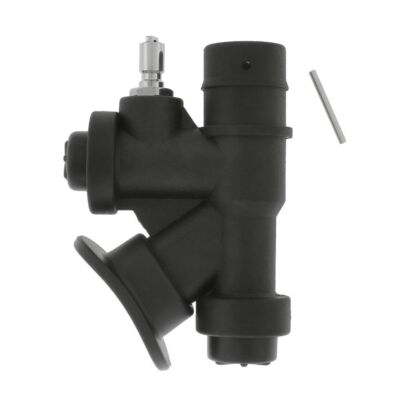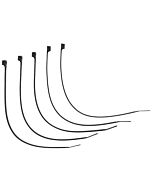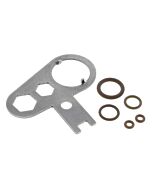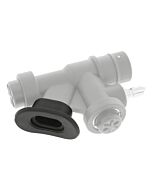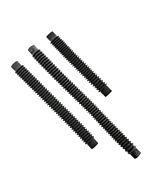K-Style Power Inflator for 1-Inch Corrugated Hose
- A reliable drift-pin design replacement 45° K-style power inflator
- Compatible with 1-inch inside diameter corrugated rubber hoses
- Includes mouth guard and pin for pull-to-dump cable
- The attaching hardware (clamps or zip ties) is not included
K-Style Power Inflator for 1-Inch Corrugated Hose
This inflator fits the larger 1-inch inside diameter oval crush proof corrugated rubber hose found on most technical style wings. For an inflator that fits the 3/4-inch hose found on most sport BCDs and some wings. See our Micro-Inflator.
The BC quick disconnect post on the DGX Oral Power Inflator is compatible with the slide-lock fitting found on most ordinary low pressure BC inflator hoses. This widely used drift-pin design power inflator fits the 1-inch inside diameter corrugated rubber hose found on most technical BC aircells including those from Dive Rite, Halcyon, Highland, HOG, Hollis, IST Dolphin, Light Monkey, OMS, OxyCheq, White Arrow and many other brands.
Includes a removable rubber mouth guard and the pin for a pull-to-dump cable.
Push the button on the end to deflate or orally inflate the BC via the mouthpiece; push the other button for power inflation via the low pressure BC hose. Push both buttons simultaneously to dump gas out the mouthpiece directly from the low-pressure hose, a neat trick allowing you to leave your second stage in your mouth while still inflating a lift bag or SMB.
This product does not include attaching hardware (ie. zip ties or clamps that secure the product to your corrugated hose.)The attaching hardware is available separately.
Some inflation assemblies have a cable that runs through the inside of the corrugated hose. This cable is attached to the power inflator using the pin, such that if you pull down on the inflator itself (and thus pull the cable), a dump valve at the top of the inflator assembly is activated. This feature is usually called 'pull-to-dump' or 'remote-exhaust.' Your inflation assembly may or may not have the feature and the cable, but we include a replacement pin just in case you do need one. If the pin turns out to be unneeded you may safely discard it.
| Brand | DGX |
|---|---|
| SKU | DX-202930 |
| Weight | 0.270000 |
Customer Reviews
 WARNING
WARNING
The power inflator service tool, o-ring kit and overhaul instructions are a 'save-a-dive' solution for qualified professionals but our recommendation is to replace, not service, your power inflator if it develops any problems. Improper service could cause a failure of buoyancy control, which has serious and life threatening consequences.
YOU MAY ALSO BE INTERESTED IN THE FOLLOWING PRODUCT(S)
The History Behind the K-inflator and Drift-Pin vs. Schrader Inflators
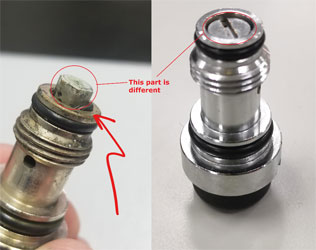
The "K" shaped drift-pin design inflator found on buoyancy control aircells (aka wings) in the technical diving community was originally designed and made by the late Larry Scott of Huntington Beach, CA in the 1970s. Today there are many manufacturers of K-inflators and some of them just copy Larry’s original design. In that design, a dynamic o-ring rubs against a v-cut opening at the end of the valve. This creates additional wear on the dynamic o-ring so to mitigate wear the design relies upon a firmer Shore-A90 durometer o-ring. In some more recent K-inflator designs, the sealing o-ring does not rub against the v-cut opening and instead just touches on a flat opening at the end. With this change, the inflator can use a common Shore-A70 durometer softer rubber o-ring.
The original design K-inflator (or the equivalent copies) could be unsafe if improperly serviced and can be identified by the hex nut protruding from the end of the inflator cartridge. A potential life-threatening hazard might occur if the service technician, or a diver, repairs a leaking original Larry Scott design K-inflator or equivalent copy by substituting softer o-rings. There is a risk of the softer o-ring being blown out of position and extruding out the end of the cartridge. See the photo for an example - when this happens, the inflator may become stuck open and rapidly inflate the BCD with a subsequent loss of buoyancy control! Statistics from DAN suggest that a failure of buoyancy control can be one of the most life threatening types of dive accidents.
The K-inflator sold by Dive Gear Express and others such as the Highland brand are the improved version with a slotted screw head on the end of the cartridge. Unfortunately, you can't be sure what you have unless you remove the cartridge from the body of the inflator for inspection. This is the reason Dive Gear Express recommends just replacing, rather servicing, any leaking inflator. (However our "save-a-dive" K-inflator service kit does include the firmer Shore-A90 o-rings in nitrox compatible Viton.)
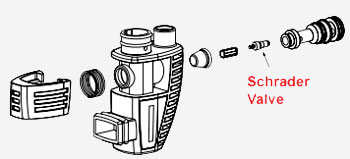
With his drift-pin design, Larry was solving a problem that is common to sport diving power inflators and the reason the K-inflator has been almost universally adopted by technical divers. The power inflators seen on many (probably most) sport diving BC jackets are based on using the Schrader valve; see illustration of a typical sport diving inflator design. Schrader valves are a tiny off-the-shelf assembly which corrodes easily, plus in this application they often get salt deposits caked in their springs. Unless meticulously maintained, they eventually do not seal fully closed and then dribble gas into the BCD. This results in the diver finding themselves gradually becoming inexplicably buoyant and requires periodically dumping gas from the BCD even though none was added by the diver. Compared to the Schrader valve design inflators, the benefit of using Mr. Scott's drift-pin valve design in his K-inflator is the improved reliability.
Want to check your power inflator for a leak? Setup your BCD and regulator on a tank with at least {300 psi | 20 bar} remaining then open the tank valve to pressurize the regulator. Make sure the low-pressure BC inflator hose is firmly connected and the over-pressure relief & dump valve on the BC is working, then use the oral mouthpiece on the inflator to suck out all the gas in the BCD bladder. Let the entire rig sit overnight. If you return in the morning to find your BCD inflated then your power inflator is leaking and should be replaced.
